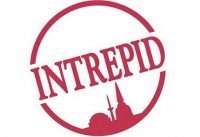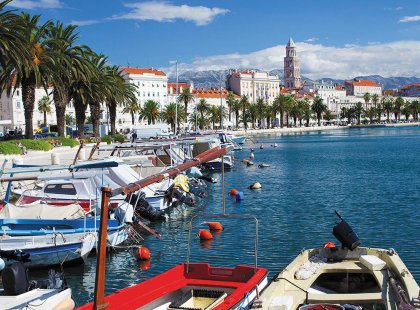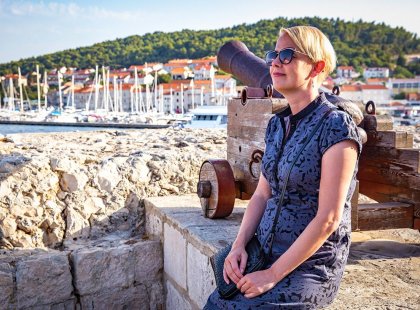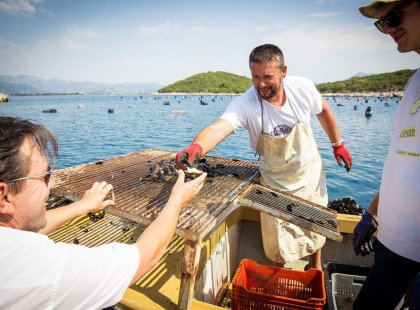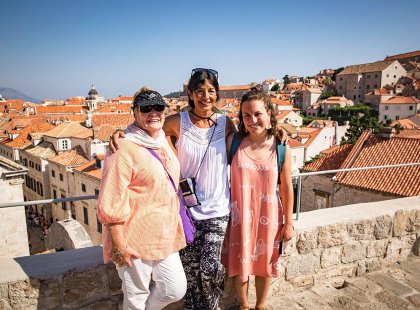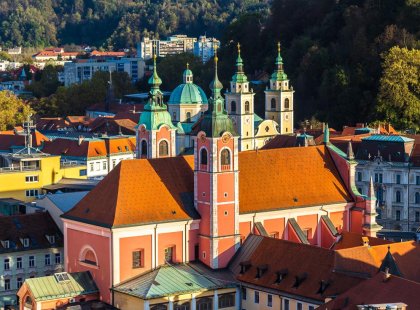Slovenia & Croatia Real Food Adventure
12 days
From
$ 3555
Duration12 days
Eat your way from Ljubljana to Dubrovnik via Motovun, Plitvice National Park, Zadar, Split and Korcula. If it’s a gourmet feast you want, a gourmet feast you shall get! This food-inspired escapade through Bled, Piran, Motovun, Plitvice National Park, Zadar, Split, Korcula and Dubrovnik includes visits to salt pans, a truffle farm, wineries, fishing villages and more. Discover why Istria is considered one of the world's leading producers of quality olive oil; eat mouth-watering, slow-cooked meat cooked Dalmatian-style under a metal bell; and raise a glass of refosk (Slovenian wine) or slivovitz (plum brandy) and shout ‘zivjeli!’ to the simple, home-style cuisine this region is famous for.
-
Duration: 12 daysService level: Standard
-
Physical Grading: Light
-
Ends in: Hotel DubrovnikAges: 15+
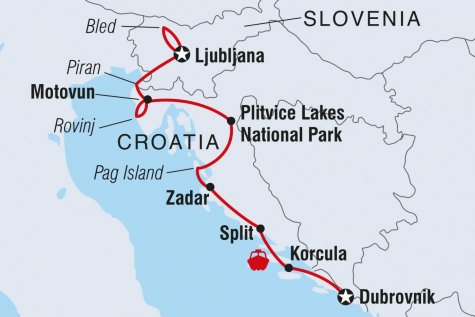
Itinerary
Day 1: Ljubljana
Zivjo! Welcome to Slovenia. Known as ‘Europe in Miniature’, tiny Slovenia has a huge heart and a wealth of diversity. The soaring Julian Alps capture a touch of Switzerland, the radiating coastline oozes Mediterranean charm, and Bled’s island church appears to have come straight out of a fairytale. This small country is home to a surprisingly complex cuisine, divided into more than 20 culinary regions, according to local ethnologists. Best known for hearty, alpine stews, goulash and sauerkraut, Slovenia also boasts wonderful cakes and strudels, not to mention the culinary treasures found in the coastal Karst region, including teran (wine), prsut (air-dried ham) and sensational olive oils.
Your adventure begins with a welcome meeting tonight at 6pm. Please ask reception to confirm the time and place of your meeting. Have your insurance details and next of kin information on hand for verification by your leader. If you can't arrange a flight that will arrive in time, you may wish to arrive a day early so you're able to attend. Picturesque Ljubljana is perfect for starting a food odyssey, with a surprisingly diverse food scene that belies its size – great local eateries, progressive modern restaurants, street food, cafes and cake shops. Toast to your trip with a glass of Slovenia's national drink: schapps (snopec in Slovene). This fruit-based liqueur comes in a variety of flavour incarnations, although the local favourite is viljamoka, flavoured with Williams pear. Your leader will then suggest a great place in the heart of the city to sample some delicious traditional dishes.
Your adventure begins with a welcome meeting tonight at 6pm. Please ask reception to confirm the time and place of your meeting. Have your insurance details and next of kin information on hand for verification by your leader. If you can't arrange a flight that will arrive in time, you may wish to arrive a day early so you're able to attend. Picturesque Ljubljana is perfect for starting a food odyssey, with a surprisingly diverse food scene that belies its size – great local eateries, progressive modern restaurants, street food, cafes and cake shops. Toast to your trip with a glass of Slovenia's national drink: schapps (snopec in Slovene). This fruit-based liqueur comes in a variety of flavour incarnations, although the local favourite is viljamoka, flavoured with Williams pear. Your leader will then suggest a great place in the heart of the city to sample some delicious traditional dishes.
Day 2: Bled / Ljubljana
This morning, take a public bus to Bled (approximately 1 hour). Situated on stunning Lake Bled at the edge of the Julian Alps, this is a postcard location par excellence. You will have approximately 5 hours in Bled, but we’ve come for one reason – a delicious cream cake called kremna rezina (kremsnita to the locals). It’s thought to have been invented in the kitchens of Hotel Park in 1953 by Ištvan Lukačevič, chef of the hotel's confectionery store. Since its invention, more than 10 million kremsnita have been baked at the hotel's patisserie. Tuck in to your own slice to find out what all the fuss is about. Afterwards, perhaps hike up to Bled Castle or visit the 17th century baroque Church of the Assumption, or simply take a stroll and enjoy some people watching. Return to Ljubljana in the early afternoon.
Head over to a Slovenian culinary workshop in the evening to pick up some tips for creating some traditional Slovenian fare at home, followed by a hearty meal. Your hosts will provide a tasting of typical Slovenian cold starters so you won't get hungry as you cook!
Head over to a Slovenian culinary workshop in the evening to pick up some tips for creating some traditional Slovenian fare at home, followed by a hearty meal. Your hosts will provide a tasting of typical Slovenian cold starters so you won't get hungry as you cook!
Meals: B, D
Day 3: Piran / Motovun
Travel by public bus to Piran this morning (approximately 2 hours). Piran is a coastal town, located near the border of Italy and Croatia. The region is renowned for its production of fantastic quality olive oils, wine (especially the distinctive teran and refošk), as well as a cured ham called prsut. This is air-dried in the cold, dry wind known as the bura, which sweeps down to the coast from inland. Take a tasting tour of the township, then venture into a family-owned konoba (restaurant) for lunch and a wine tasting. Everything you eat is grown and prepared on the property. Next, head to the nearby salt pans of Piran where salt is still manually harvested with traditional tools according to a seven centuries' old process. Cross the border into Croatia.
Croatia has long piqued the interest of curious travellers searching for sunshine, sand and scenery, with charming cobblestone towns and World Heritage sites. Recently it has gained recognition as an exciting food and wine destination, with the region of Istria leading the charge as the culinary capital of the country. Arrive at your final destination, the Istrian town of Motovun, by early evening.The evening is free for your own food adventures.
Croatia has long piqued the interest of curious travellers searching for sunshine, sand and scenery, with charming cobblestone towns and World Heritage sites. Recently it has gained recognition as an exciting food and wine destination, with the region of Istria leading the charge as the culinary capital of the country. Arrive at your final destination, the Istrian town of Motovun, by early evening.The evening is free for your own food adventures.
Meals: B, L
Day 4: Motovun
Motovun is one of the best preserved medieval Istrian towns in Croatia, with houses scattered all over the hill and a spectacular view of Mirna River Valley. Motovun Forest is the best place for hunting the famous Istrian truffle, and the nearby village of Livade is considered the truffle capital of Istria. Take a walk through the nearby woods with an experienced truffle hunter, and learn about this intriguing vocation. Perhaps sniff out a truffle of your own! Then enjoy a tasting of regional specialties including truffles (of course), omelet over an open fire, olives and honey.
Drive to the romantic Croatian town of Rovinj, one of the best-kept towns on the Adriatic Coast (approximately 1 hour). Among Rovinj's qualities is the beautiful, architecturally intact old town centre, with a relaxed Mediterranean feel. Through the centuries, Rovinj’s character has enchanted many an artist or writer, including Jules Verne. Take an orientation walk through the old town. For fans of oysters, a cruise on Lim Bay is highly recommended. Stop into an oyster farm and taste freshly shucked bivalves straight from the ocean.
Spend the evening at your leisure and seek out a local Mediterranean restaurant.
Drive to the romantic Croatian town of Rovinj, one of the best-kept towns on the Adriatic Coast (approximately 1 hour). Among Rovinj's qualities is the beautiful, architecturally intact old town centre, with a relaxed Mediterranean feel. Through the centuries, Rovinj’s character has enchanted many an artist or writer, including Jules Verne. Take an orientation walk through the old town. For fans of oysters, a cruise on Lim Bay is highly recommended. Stop into an oyster farm and taste freshly shucked bivalves straight from the ocean.
Spend the evening at your leisure and seek out a local Mediterranean restaurant.
Day 5: Plitvice National Park / Rakovica
Take a private transfer to the stunning World Heritage-listed Plitvice Lakes National Park (approximately 4 hours). It’s the largest national park in Croatia and known to be one of the oldest in South-East Europe – a misty Eden of endless waterfalls and spectral blue lakes. The waters tumble from a high, tree-lined ridge down through the valley before skirting dense forests of beech, spruce and pine. The Upper Lakes are in the dolomite cliffs, where rushing water weaves in and out of the karst before dropping dramatically down to the forest, grottoes and steep cliffs of the Lower Lakes. This interplay of water, rock, and plant-life creates a wondrous, dynamic landscape, changing the water colour from azure to bright green, deep blue to grey.
After taking in this one-of-a-kind landscape, head onwards to Rakovica village where you’ll stay the night. Dinner includes a delicious home cooked meal provided by your hosts – a hearty serving of traditional Croatian kotlovina. This mixed meat dish consists mainly of pork schnitzels and sausages, traditionally made in a cauldron (which translates to kotlovina) for large groups of people, feasts, holiday celebrations or just parties. The hosts will let you witness first hand how the meal is prepared before you tuck in, enjoying the robust flavours and hints of spice before turning in for the night.
After taking in this one-of-a-kind landscape, head onwards to Rakovica village where you’ll stay the night. Dinner includes a delicious home cooked meal provided by your hosts – a hearty serving of traditional Croatian kotlovina. This mixed meat dish consists mainly of pork schnitzels and sausages, traditionally made in a cauldron (which translates to kotlovina) for large groups of people, feasts, holiday celebrations or just parties. The hosts will let you witness first hand how the meal is prepared before you tuck in, enjoying the robust flavours and hints of spice before turning in for the night.
Meals: D
Day 6: Pag Island to Zadar
Farewell your hosts and then travel by bus to nearby Pag Island (approximately 2 hours). The karst island of Pag is home to sheep and a determined group of islanders who wring themselves a living from the barren, rocky landscape. Settled in pre-Roman times, the island has been at the mercy of the shifting fortunes of various Dalmatian rulers, and today reminders of its prosperous salt-mining past lie in the main town. Meet a producer of the island's renowned cheese ‘paski sir’. This artisan sheep's milk cheese has long been a valued commodity of the island. Discover more about the production process and enjoy a tasting. There will also be an option to enjoy a specialty dish of the region - lamb cooked peka-style - beneath a metal bell. This succulent dish is not to be missed, as Dalmatian lamb is highly prized. Continue on to the walled city of Zadar (approximately 1.5 hours). For centuries Zadar was the capital city of Dalmatia, and the city's rich heritage is visible at every step. It’s also celebrated for many culinary treasures, including fresh seafood, the sheep and goats that are reared for their meat and milk in the mountains to the north, and the wonderful fresh produce that is grown in a broad belt of land surrounding Zadar. Don't forget to try the famous liqueur, Maraskino, made from locally-grown maraschino cherries according to a centuries' old secret recipe. This unique drink was a favourite at European imperial and royal courts and has been produced in Zadar since 1821.
Meals: B
Day 7: Split
Rise early for a stroll through Zadar's vibrant fish market. The fish market is built into the city ramparts at the spot where the fishing trawlers land with their catch. This will also give you an opportunity to ogle some of the produce grown in the area. Depending on the season, you may find citrus fruits and kiwis from the islands, fresh and dried figs and home-made olive oil. The city is also home to a vibrant café culture.
Travel by public bus southeast to Split (approximately 3-4 hrs), arriving in the late afternoon. Take in vistas over vineyards, olive groves, bays, beaches, steep cliffs and islands along the way. The evening is free for your own food adventures, although your leader will have plenty of local suggestions.
Travel by public bus southeast to Split (approximately 3-4 hrs), arriving in the late afternoon. Take in vistas over vineyards, olive groves, bays, beaches, steep cliffs and islands along the way. The evening is free for your own food adventures, although your leader will have plenty of local suggestions.
Meals: B
Day 8: Split
A vibrant mixture of golden history and present-day delights, the city of Split grew out from the remains of Diocletian's Palace - some of the most impressive ruins on the Mediterranean.
Today you’ll get the chance to learn more about the sights and flavours of the city as you embark on a walking tour of the city with a local foodie. Take Diocletian's Palace and wander the district's winding streets, before heading into the green market to learn about Croatian agriculture. Taste some artisanal olive oil, pick some mouthwatering local sweets (orancini and lemoncini) before finally paying a visit to the finest chocolatier in town. Finish with a lunch of beer and burek.
The rest of the day is free for you to explore. Perhaps take in the fantastically preserved basements under the city, along with the Cathedral in Docletian’s Peristyle and Jupiter’s Temple. As the evening rolls in, you may choose to take another cooking class or put your feet up and relax over a hearty Croatian meal.
Today you’ll get the chance to learn more about the sights and flavours of the city as you embark on a walking tour of the city with a local foodie. Take Diocletian's Palace and wander the district's winding streets, before heading into the green market to learn about Croatian agriculture. Taste some artisanal olive oil, pick some mouthwatering local sweets (orancini and lemoncini) before finally paying a visit to the finest chocolatier in town. Finish with a lunch of beer and burek.
The rest of the day is free for you to explore. Perhaps take in the fantastically preserved basements under the city, along with the Cathedral in Docletian’s Peristyle and Jupiter’s Temple. As the evening rolls in, you may choose to take another cooking class or put your feet up and relax over a hearty Croatian meal.
Meals: L
Day 9: Korcula
Catch a morning ferry to Korcula (approximately 3.5 hours). Upon arrival, embark on an orientation walk to get a feel for this historic fortified island town, including the Cathedral of St Mark, the 15th-century Franciscan monastery and the massive fortifications surrounding the city. A free afternoon gives the opportunity to take in the serenity of the local forest’s tranquil inlets and character-filled vineyards, located on an island where natives believe Marco Polo was born. Whether or not this can be proved (the Venetians have a similar claim), Korcula is steeped in a long history that’s resulted in Greek, Slav and Roman settlers – resulting in a romantic and evocative cultural old town. What's more, there are plenty of warm beaches to relax on if that's more your speed. You might like to take a swim, walk around the bays and villages near Korcula town, pay a visit to the Marco Polo Tower, go shopping, or just soak up the ambience.
Later in the evening, you will have the option to make the short journey by local bus (approximately 30 minutes) to the tiny village of Pupnat (population: 300) in the interior of the island. Consider dinner in the village, enjoying a meal made entirely from local produce. Perhaps you can drink your wine like the locals do: mixed with a bit of water. The traditional Dalmatian meat loaf, or pasticada, and fresh grilled vegetables with olive oil constitute a typical dish, all served with fresh goat and sheep cheeses and maybe some smoked ham to tie it all together. Don't forget to have a bit of travarica (a grappa-like drink made with the verbane herb) and some Korcula cakes for dessert before heading back to Korcula town.
Later in the evening, you will have the option to make the short journey by local bus (approximately 30 minutes) to the tiny village of Pupnat (population: 300) in the interior of the island. Consider dinner in the village, enjoying a meal made entirely from local produce. Perhaps you can drink your wine like the locals do: mixed with a bit of water. The traditional Dalmatian meat loaf, or pasticada, and fresh grilled vegetables with olive oil constitute a typical dish, all served with fresh goat and sheep cheeses and maybe some smoked ham to tie it all together. Don't forget to have a bit of travarica (a grappa-like drink made with the verbane herb) and some Korcula cakes for dessert before heading back to Korcula town.
Day 10: Korcula
Jump on a bike and ride east towards Lumbarda beach. The landscape of the island is dotted with vineyards, olive groves and lush forests – take the ride casually and absorb some of the beautiful landscapes surrounding the area as you pedal on by. Once arriving at Lumbarda village, explore two local wineries for a tasting. The village is revered for two white varietals, Grk and Posip, which have been produced here for centuries.
Grk is a curious drop. The wine can’t replicate itself as it only has female parts and needs to be planted with another male grape variety in order to pollinate. It seems like a lot of work to make a wine, but the end result is a glass of acidic white, featuring a robust aroma and hints of pine that has been loved around the country for ages.
Posip has also traditionally remained native to the region and despite small amounts of the grape being grown in other parts of the country, this light bodied white wine has a flavour that remains distinctive to the grapes grown in Korcula. It’s a great addition for pairing with fish or the light bodied cheeses of Croatia.
Grk is a curious drop. The wine can’t replicate itself as it only has female parts and needs to be planted with another male grape variety in order to pollinate. It seems like a lot of work to make a wine, but the end result is a glass of acidic white, featuring a robust aroma and hints of pine that has been loved around the country for ages.
Posip has also traditionally remained native to the region and despite small amounts of the grape being grown in other parts of the country, this light bodied white wine has a flavour that remains distinctive to the grapes grown in Korcula. It’s a great addition for pairing with fish or the light bodied cheeses of Croatia.
Meals: B
Day 11: Dubrovnik
Travel to Dubrovnik by public bus and ferry (approximately 4 hours). Dubrovnik is a beautiful white stone town surrounded entirely by fortifications – some might recognise it from Game of Thrones as the filming location for Kings Landing. Although it experienced devastation during the war in the early 1990s, the restored old town remains as charming as ever. With the sparkling water of the Adriatic in the background, Dubrovnik is picturesque, full of character and can easily be covered on foot.
Take an excursion across the city walls, admiring the breadth of the ocean and the rustic township below. These impressive fortifications stretch 2 kilometres (1.2 miles) and make for an easy walk. The sights of the crowded walkway of Stradun, the Bell Tower, the Bokar, Lovrijenac and St John’s Fortresses, along with excellent views of the bustling harbour make for an unforgettable journey over the top of this rustic, medieval town.
Tonight marks the last night of your food adventure – you may want to consider sharing a farewell dinner and a glass of rakjia with new friends.
Take an excursion across the city walls, admiring the breadth of the ocean and the rustic township below. These impressive fortifications stretch 2 kilometres (1.2 miles) and make for an easy walk. The sights of the crowded walkway of Stradun, the Bell Tower, the Bokar, Lovrijenac and St John’s Fortresses, along with excellent views of the bustling harbour make for an unforgettable journey over the top of this rustic, medieval town.
Tonight marks the last night of your food adventure – you may want to consider sharing a farewell dinner and a glass of rakjia with new friends.
Meals: B
Day 12: Dubrovnik
Your Real Food Adventure through Slovenia and Croatia concludes this morning. There are no activities planned for the final day and you are free to leave at any time. Should you wish to continue your food adventure through the Balkans, perhaps consider joining the Real Food Adventure Dubrovnik to Skopje, which winds its way through Montenegro, Kosovo, Albania and Macedonia. See trip code ZKZM or ZMZMC for further information.
End place: Hotel Dubrovnik
Meals: B
Inclusions
Included
- Ljubljana - Snops Tasting
- Bled - Day Trip
- Bled - Kremsnita Tasting
- Ljubljana - Slovenian Cooking Class
- Piran - Tasting Tour and Lunch
- Motovun - Truffle Hunt and Tasting
- Rovinj – Day Trip
- Plitvice Lakes National Park
- Rakovica: Home-cooked Meal
- Pag Island - Cheese Tasting
- Split - Old Town Food and Culture Tour
- Korcula - Winery Cycle Tour
- Dubrovnik - Card (1 day local transport and entry to sites)
-
Transport
Private Vehicle, Public Bus, Ferry, Taxi -
Accommodation
Hotel (11 nights)
